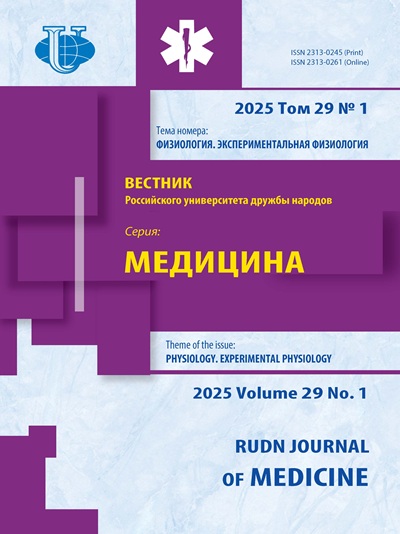Development of a technique for obtaining bioengineered tubular structures as potential vascular grafts
- Авторлар: Zakharov A.S.1,2, Vasilovsky I.N.1, Korotkova N.V.1, Mzhavanadze N.D.1, Kalinovsky S.I.1, Suchkov I.A.1, Kalinin R.E.1
-
Мекемелер:
- Ryazan State Medical University
- Ryazan regional branch of All-Russian society of inventors and innovators
- Шығарылым: Том 29, № 1 (2025): PHYSIOLOGY. EXPERIMENTAL PHYSIOLOGY
- Беттер: 73-83
- Бөлім: PHYSIOLOGY. EXPERIMENTAL PHYSIOLOGY
- URL: https://journal-vniispk.ru/2313-0245/article/view/349499
- DOI: https://doi.org/10.22363/2313-0245-2025-29-1-73-83
- EDN: https://elibrary.ru/DZSDVK
- ID: 349499
Дәйексөз келтіру
Толық мәтін
Аннотация
Relevance. The problem of searching for the creation of arterial grafts is relevant in modern vascular surgery, since currently available synthetic prostheses, xeno-, allo- and autographs have a number of disadvantages in practical use: thrombiability, stenosis, inflammation, aneurysmal extensions, etc. The solution to this problem may be the creation of a technology for obtaining bioengineered vascular prostheses based on biocompatible hydrogels. We want to demonstrate the fundamental possibility of developing such a technique in this study. Materials and Methods. At the first stage of the study, the authors used 3D modeling and photopolymer 3D printing technologies in order to manufacture a mold for creating a tissue-engineered vascular prosthesis. At the second stage of the work, the authors developed a technique for heterophase oxidative modification of sodium alginate with peroxynitrite to obtain a cytocompatible hydrogel, which was subsequently tested on human fibroblast culture by analyzing their growth pattern and metabolic activity. At the third stage of the study, a bioengineered tubular structure was created using a previously manufactured mold. Results and Discussion. We have obtained a casting mold for creating a tissue-engineered vascular prosthesis, the distinctive features of which are reusable, collapsible, easy sterilization and ease of operation. The cytocompatibility of the hydrogel obtained by us based on modified sodium alginate has been proved. It is based on a tubular structure with a length of 7 cm, a diameter of 7 mm and a wall thickness of 1 mm. It is shown that it has flexibility, elasticity and resistance to pressure above 300 mmHg. Conclusion. Thus, the authors demonstrated the possibility of obtaining bioengineered tubular structures using 3D printing molding technology and showed the possibility of obtaining and using cytocompatible polysaccharide protein hydrogels for such purposes. The researchers hope that with further improvement of the strength characteristics and adhesive properties of the material, this technique for obtaining bioengineered tubular structures can form the basis for the production technology of vascular grafts for educational, scientific and medical purposes.
Негізгі сөздер
Авторлар туралы
Alexander Zakharov
Ryazan State Medical University; Ryazan regional branch of All-Russian society of inventors and innovators
Хат алмасуға жауапты Автор.
Email: AlexanderZakharov2019@yandex.ru
ORCID iD: 0000-0002-4004-7474
SPIN-код: 4906-9088
Ryazan, Russian Federation
Ivan Vasilovsky
Ryazan State Medical University
Email: AlexanderZakharov2019@yandex.ru
ORCID iD: 0009-0005-0294-4990
Ryazan, Russian Federation
Natal’ya Korotkova
Ryazan State Medical University
Email: AlexanderZakharov2019@yandex.ru
ORCID iD: 0000-0001-7974-2450
SPIN-код: 3651-3813
Ryazan, Russian Federation
Nina Mzhavanadze
Ryazan State Medical University
Email: AlexanderZakharov2019@yandex.ru
ORCID iD: 0000-0001-5437-1112
SPIN-код: 7757-8854
Ryazan, Russian Federation
Sergey Kalinovsky
Ryazan State Medical University
Email: AlexanderZakharov2019@yandex.ru
ORCID iD: 0000-0002-6222-3053
SPIN-код: 2506-0080
Ryazan, Russian Federation
Igor Suchkov
Ryazan State Medical University
Email: AlexanderZakharov2019@yandex.ru
ORCID iD: 0000-0002-1292-5452
SPIN-код: 6473-8662
Ryazan, Russian Federation
Roman Kalinin
Ryazan State Medical University
Email: AlexanderZakharov2019@yandex.ru
ORCID iD: 0000-0002-0817-9573
SPIN-код: 5009-2318
Ryazan, Russian Federation
Әдебиет тізімі
- Ratner B. Vascular Grafts: Technology Success/Technology Failure. BME Frontiers. 2023;4:0003. doi: 10.34133/bmef.0003
- Spadaccio C, Rainer A, Barbato R, Trombetta M, Chello M, Meyns B. The long-term follow-up of large-diameter Dacron® vascular grafts in surgical practice: a review. Journal of cardiovascular surgery (Torino). 2019;60(4):501—513. doi: 10.23736/S0021-9509.16.08061-7
- Mufty H, Van Den Eynde J, Meuris B, Metsemakers WJ, Van Wijngaerden E, Vandendriessche T, Steenackers HP, Fourneau I. Pre-clinical in vivo Models of Vascular Graft Coating in the Prevention of Vascular Graft Infection: A Systematic Review. European journal of vascular and endovascular surgery. 2021;62(1):99—118. doi: 10.1016/j.ejvs.2021.02.054
- Jeong Y, Yao Y, Yim EKF. Current understanding of intimal hyperplasia and effect of compliance in synthetic small diameter vascular grafts. Biomaterials science. 2020;8(16):4383—4395. doi: 10.1039/d0bm00226g
- Zakharov AS, Kalinin RE, Suchkov IA, Korotkova NV, Kovalev SA, Mzhavanadze ND. Modern possibilities of bioengineering in the creation of vascular grafts. Russian journal of thoracic and cardiovascular surgery. 2022;64(3):265—272. doi: 0.2402/0236-2791-2022-64-3-265-272 (In Russian).
- Antonova LV, Matveeva VG, Barbarash LS. Electrospinning and biodegradable small-diameter vascular grafts: problems and solutions (review). Complex issues of cardiovascular diseases. 2015;3:12—22. (In Russian).
- Shannon LMD, Juliana LB, Laura EN. Bioengineered Vascular Grafts: Can We Make Them Off-the-Shelf? Trends Cardiovasc Med. 2011;23(3):83—89. doi: 10.1016/j.tcm.2012.03.004
- Cameron RB. Bioengineered vascular grafts: So close and yet so far. J Thorac Cardiovasc Surg. 2018;156(5):1823—1824. doi: 10.1016/j.jtcvs.2018.06.042
- Hao D, Fan Y, Xiao W, Liu R, Pivetti C, Walimbe T, Guo F, Zhang X, Farmer DL, Wang F, Panitch A, Lam KS, Wang A. Rapid endothelialization of small diameter vascular grafts by a bioactive integrin-binding ligand specifically targeting endothelial progenitor cells and endothelial cells. Acta Biomater. 2020;108:178—193. doi: 10.1016/j.actbio.2020.03.005
- Moore MJ, Tan RP, Yang N, Rnjak-Kovacina J, Wise SG. Bioengineering artificial blood vessels from natural materials. Trends Biotechnol. 2022;40(6):693—707. doi: 10.1016/j.tibtech.2021.11.003
- Li Y, Zhou Y, Qiao W, Shi J, Qiu X, Dong N. Application of decellularized vascular matrix in small-diameter vascular grafts. Front Bioeng Biotechnol. 2023;10:1081233. doi: 10.3389/fbioe.2022.1081233
- Lin CH, Hsia K, Ma H, Lee H, Lu JH. In Vivo Performance of Decellularized Vascular Grafts: A Review Article. Int J Mol Sci. 2018;19(7):2101. doi: 10.3390/ijms19072101
- Cai Z, Gu Y, Cheng J, Li J, Xu Z, Xing Y, Wang C, Wang Z. Decellularization, cross-linking and heparin immobilization of porcine carotid arteries for tissue engineering vascular grafts. Cell Tissue Bank. 2019;20(4):569—578. doi: 10.1007/s10561-019-09792-5
- Kretov EI, Zapolotsky EN, Tarkova AR, Prokhorikhin AA, Boykov AA, Malaev DU. Electrospinning for the design of medical supplies. Bulletin of Siberian Medicine. 2020;19(2):153—162. doi: 10.20538/1682-0363-2020-2-153-162. (In Russian).
- Sevost’ianova VV, Elgudin IaA, Glushkova TV, Wnek G, Liubysheva T, Emancipator S, Kudriavtseva IuA, Borisov VV, Golovkin AS, Barbarash LS. Use of polycaprolactone grafts for small-diameter blood vessels. Angiol Sosud Khir. 2015;21(1):44—53. (In Russian).
- Grasl C, Stoiber M, Röhrich M, Moscato F, Bergmeister H, Schima H. Electrospinning of small diameter vascular grafts with preferential fiber directions and comparison of their mechanical behavior with native rat aortas. Mater Sci Eng C Mater Biol Appl. 2021;124:112085. doi: 10.1016/j.msec.2021.112085
- Woods I, Flanagan TC. Electrospinning of biomimetic scaffolds for tissue-engineered vascular grafts: threading the path. Expert Rev Cardiovasc Ther. 2014;12(7):815—832. doi: 10.1586/14779072.2014.925397
- Lu X, Zou H, Liao X, Xiong Y, Hu X, Cao J, Pan J, Li C, Zheng Y. Construction of PCL-collagen@PCL@PCL-gelatin three-layer small diameter artificial vascular grafts by electrospinning. Biomed Mater. 2022;18(1). doi: 10.1088/1748-605X/aca269
- Abdollahi S, Boktor J, Hibino N. Bioprinting of freestanding vascular grafts and the regulatory considerations for additively manufactured vascular prostheses. Transl Res. 2019;211:123—138. doi: 10.1016/j.trsl.2019.05.005
- Fazal F, Raghav S, Callanan A, Koutsos V, Radacsi N. Recent advancements in the bioprinting of vascular grafts. Biofabrication. 2021;13(3). doi: 10.1088/1758—5090/ac0963
- Hou YC, Cui X, Qin Z, Su C, Zhang G, Tang JN, Li JA, Zhang JY. Three-dimensional bioprinting of artificial blood vessel: Process, bioinks, and challenges. Int J Bioprint. 2023;9(4):740. doi: 10.18063/ijb.740
- Weekes A, Bartnikowski N, Pinto N, Jenkins J, Meinert C, Klein TJ. Biofabrication of small diameter tissue-engineered vascular grafts. Acta Biomater. 2022;138:92—111. doi: 10.1016/j.actbio.2021.11.012
Қосымша файлдар








